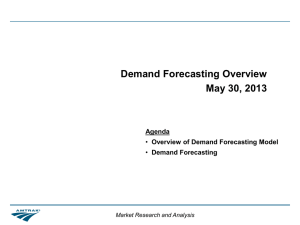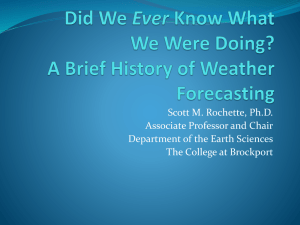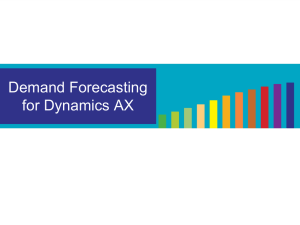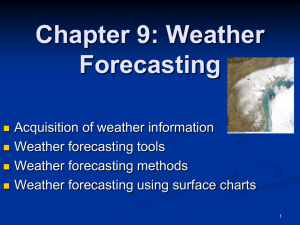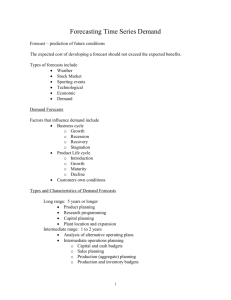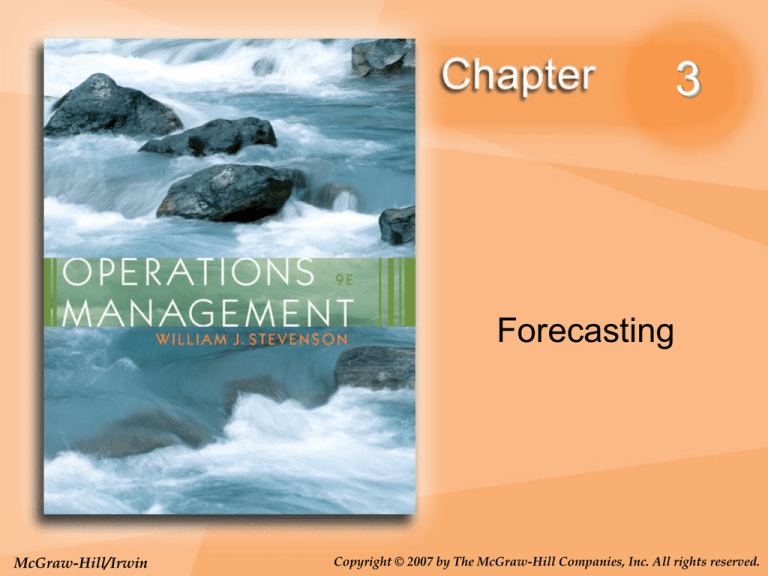
3
Forecasting
McGraw-Hill/Irwin
Copyright © 2007 by The McGraw-Hill Companies, Inc. All rights reserved.
FORECAST:
A statement about the future value of a
variable of interest such as demand.
Forecasting is used to make informed
decisions.
Long-range
Short-range
3-2
Forecasts
Forecasts affect decisions and activities
throughout an organization
Accounting, finance
Human resources
Marketing
MIS
Operations
Product / service design
3-3
Uses of Forecasts
Accounting
Cost/profit estimates
Finance
Cash flow and funding
Human Resources
Hiring/recruiting/training
Marketing
Pricing, promotion, strategy
MIS
IT/IS systems, services
Operations
Schedules, workloads
Product/service design
New products and services
3-4
Features of Forecasts
Assumes causal system
past ==> future
Forecasts rarely perfect because of
randomness
Forecasts more accurate for
groups vs. individuals
I see that you will
get an A this semester.
Forecast accuracy decreases
as time horizon increases
3-5
Elements of a Good Forecast
Timely
Reliable
Accurate
Written
3-6
Steps in the Forecasting Process
“The forecast”
Step 6 Monitor the forecast
Step 5 Make the forecast
Step 4 Obtain, clean and analyze data
Step 3 Select a forecasting technique
Step 2 Establish a time horizon
Step 1 Determine purpose of forecast
3-7
Types of Forecasts
Judgmental - uses subjective inputs
Time series - uses historical data
assuming the future will be like the
past
Associative models - uses
explanatory variables to predict the
future
3-8
Judgmental Forecasts
Executive opinions
Sales force opinions
Consumer surveys
Outside opinion
Delphi method
Opinions of managers and staff
Achieves a consensus forecast
3-9
Time Series Forecasts
Trend - long-term movement in data
Seasonality - short-term regular
variations in data
Cycle – wavelike variations of more than
one year’s duration
Irregular variations - caused by unusual
circumstances
Random variations - caused by chance
3-10
Forecast Variations
Figure 3.1
Irregular
variatio
n
Trend
Cycles
90
89
88
Seasonal variations
3-11
Naive Forecasts
Uh, give me a minute....
We sold 250 wheels last
week.... Now, next week
we should sell....
The forecast for any period equals
the previous period’s actual value.
3-12
Naïve Forecasts
Simple to use
Virtually no cost
Quick and easy to prepare
Easily understandable
Cannot provide high accuracy
3-13
Uses for Naïve Forecasts
Stable time series data
F(t) = A(t-1)
Seasonal variations
F(t) = A(t-n)
3-14
Techniques for Averaging
Moving average
Weighted moving average
Exponential smoothing
3-15
Moving Averages
Moving average – A technique that averages a
number of recent actual values, updated as
new values become available.
Ft = MAn=
At-n + … At-2 + At-1
n
Weighted moving average – More recent
values in a series are given more weight in
computing the forecast.
Ft = WMAn=
wnAt-n + … wn-1At-2 + w1At-1
3-16
Simple Moving Average
Actual
MA5
47
45
43
41
39
37
MA3
35
1
2
3
Ft = MAn=
4
5
6
7
8
9
10 11 12
At-n + … At-2 + At-1
n
3-17
Exponential Smoothing
Ft = Ft-1 + (At-1 - Ft-1)
• Premise--The most recent observations
might have the highest predictive value.
Therefore, we should give more weight to
the more recent time periods when
forecasting.
3-18
Exponential Smoothing
Ft = Ft-1 + (At-1 - Ft-1)
Weighted averaging method based on
previous forecast plus a percentage of the
forecast error
A-F is the error term, is the % feedback
3-19
Example 3 - Exponential Smoothing
Period
Actual
1
2
3
4
5
6
7
8
9
10
11
12
Alpha = 0.1 Error
42
40
43
40
41
39
46
44
45
38
40
42
41.8
41.92
41.73
41.66
41.39
41.85
42.07
42.36
41.92
41.73
Alpha = 0.4 Error
-2.00
1.20
-1.92
-0.73
-2.66
4.61
2.15
2.93
-4.36
-1.92
42
41.2
41.92
41.15
41.09
40.25
42.55
43.13
43.88
41.53
40.92
-2
1.8
-1.92
-0.15
-2.09
5.75
1.45
1.87
-5.88
-1.53
3-20
Picking a Smoothing Constant
Actual
Demand
50
.4
45
.1
40
35
1
2
3
4
5
6
7
8
9 10 11 12
Period
3-21
Common Nonlinear Trends
Figure 3.5
Parabolic
Exponential
Growth
3-22
Linear Trend Equation
Ft
Ft = a + bt
0 1 2 3 4 5
t
Ft = Forecast for period t
t = Specified number of time periods
a = Value of Ft at t = 0
b = Slope of the line
3-23
Calculating a and b
n (ty) - t y
b =
2
2
n t - ( t)
y - b t
a =
n
3-24
Linear Trend Equation Example
t
Week
1
2
3
4
5
2
t
1
4
9
16
25
t = 15
t2 = 55
2
(t) = 225
y
Sales
150
157
162
166
177
ty
150
314
486
664
885
y = 812 ty = 2499
3-25
Linear Trend Calculation
b = 5 (2499) - 15(812) = 12495-12180 = 6.3
5(55) - 225
275 -225
a = 812 - 6.3(15) = 143.5
5
y = 143.5 + 6.3t
3-26
Techniques for Seasonality
Seasonal variations
Regularly repeating movements in series values
that can be tied to recurring events.
Seasonal relative
Percentage of average or trend
Centered moving average
A moving average positioned at the center of the
data that were used to compute it.
3-27
Associative Forecasting
Predictor variables - used to predict values
of variable interest
Regression - technique for fitting a line to a
set of points
Least squares line - minimizes sum of
squared deviations around the line
3-28
Linear Model Seems Reasonable
X
7
2
6
4
14
15
16
12
14
20
15
7
Y
15
10
13
15
25
27
24
20
27
44
34
17
Computed
relationship
50
40
30
20
10
0
0
5
10
15
20
25
A straight line is fitted to a set of sample points.
3-29
Linear Regression Assumptions
Variations around the line are random
Deviations around the line normally
distributed
Predictions are being made only within the
range of observed values
For best results:
Always plot the data to verify linearity
Check for data being time-dependent
Small correlation may imply that other variables
are important
3-30
Forecast Accuracy
Error - difference between actual value and
predicted value
Mean Absolute Deviation (MAD)
Average absolute error
Mean Squared Error (MSE)
Average of squared error
Mean Absolute Percent Error (MAPE)
Average absolute percent error
3-31
MAD, MSE, and MAPE
MAD
=
Actual
forecast
n
MSE
=
( Actual
forecast)
2
n -1
MAPE =
( Actual
forecas
t
n
/ Actual*100)
3-32
MAD, MSE and MAPE
MAD
Easy to compute
Weights errors linearly
MSE
Squares error
More weight to large errors
MAPE
Puts errors in perspective
3-33
Example 10
Period
1
2
3
4
5
6
7
8
MAD=
MSE=
MAPE=
Actual
217
213
216
210
213
219
216
212
Forecast
215
216
215
214
211
214
217
216
(A-F)
2
-3
1
-4
2
5
-1
-4
-2
|A-F|
2
3
1
4
2
5
1
4
22
(A-F)^2
4
9
1
16
4
25
1
16
76
(|A-F|/Actual)*100
0.92
1.41
0.46
1.90
0.94
2.28
0.46
1.89
10.26
2.75
10.86
1.28
3-34
Controlling the Forecast
Control chart
A visual tool for monitoring forecast errors
Used to detect non-randomness in errors
Forecasting errors are in control if
All errors are within the control limits
No patterns, such as trends or cycles, are
present
3-35
Sources of Forecast errors
Model may be inadequate
Irregular variations
Incorrect use of forecasting technique
3-36
Tracking Signal
•Tracking signal
–Ratio of cumulative error to MAD
(Actual-forecast)
Tracking signal =
MAD
Bias – Persistent tendency for forecasts to be
Greater or less than actual values.
3-37
Choosing a Forecasting
Technique
No single technique works in every
situation
Two most important factors
Cost
Accuracy
Other factors include the availability of:
Historical data
Computers
Time needed to gather and analyze the data
Forecast horizon
3-38
Operations Strategy
Forecasts are the basis for many decisions
Work to improve short-term forecasts
Accurate short-term forecasts improve
Profits
Lower inventory levels
Reduce inventory shortages
Improve customer service levels
Enhance forecasting credibility
3-39


